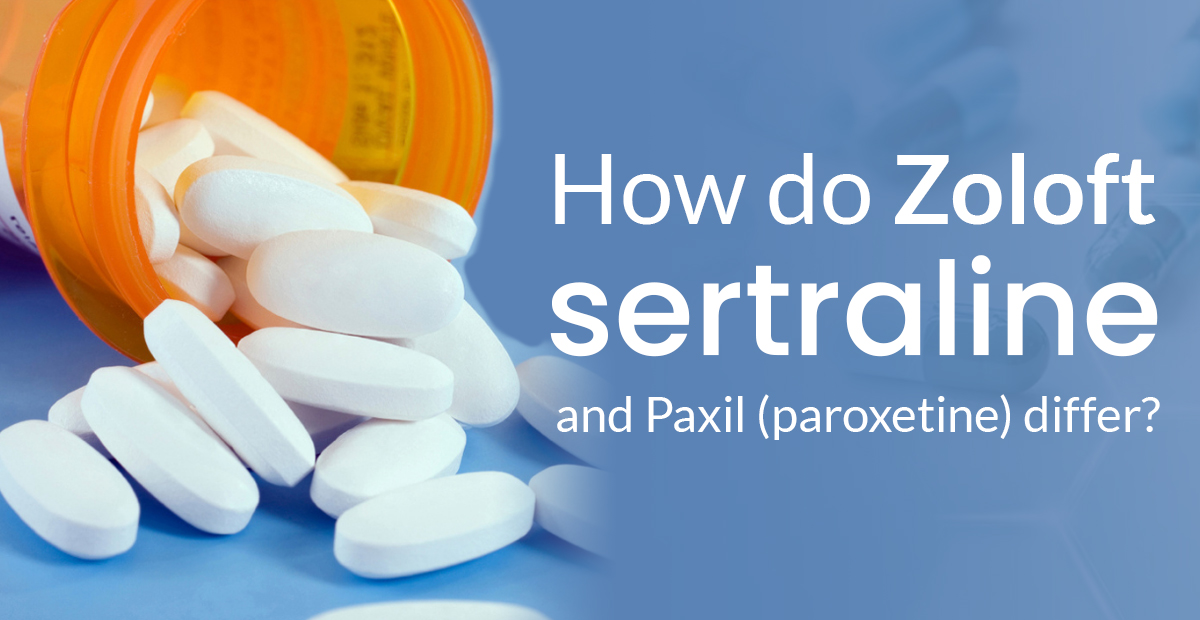
Is Sertraline a Better med than Paroxetine for Depression?
How do Zoloft (sertraline) and Paxil (paroxetine) differ?
Zoloft (sertraline) and Paxil (paroxetine) are selective serotonin reuptake inhibitor (SSRI) antidepressants prescribed for the treatment of depression, OCD, PTSD, social anxiety disorder, and premenstrual dysphoric disorder (PMDD).
Additionally, Zoloft is used to treat panic disorder.
Similar side effects of Zoloft and Paxil include fatigue, sleep problems (insomnia), nausea, constipation, appetite loss, headache, diarrhoea, dry mouth, and increased sweating.
Zoloft has side effects that differ from those of Paxil, including anxiety, dizziness, tremor, skin rash, upset stomach, abnormal ejaculation, diminished sexual interest, and weight loss.
Paxil has distinct side effects than Zoloft, including anxiety and weakness.
Do not abruptly stop taking Zoloft or Paxil, as you may experience unpleasant withdrawal symptoms.
How do Zoloft and Paxil differ?
Zoloft (sertraline) is a selective serotonin reuptake inhibitor (SSRI) antidepressant used to treat depression, OCD, PTSD, social anxiety disorder, panic disorder, and premenstrual dysphoric disorder (PMDD). Other SSRIs include paroxetine (Brisdelle, Paxil, Paxil CR, Pexeva), citalopram (Celexa), fluoxetine (Prozac, Sarafem), and fluvoxamine (Luvox CR). Experts believe that imbalances between serotonin and other neurotransmitters may lead to depression. Drugs such as Zoloft may restore the chemical equilibrium of the brain’s neurotransmitters. SSRIs inhibit serotonin reuptake, hence altering serotonin levels in the brain. A serotonin equilibrium is attained between attachment to neighbouring nerves and re-absorption.
Paxil (paroxetine) is an SSRI antidepressant prescribed for the treatment of depression, OCD, PTSD, PMDD, and social anxiety disorder. Other SSRIs include sertraline (Zoloft), citalopram (Celexa), and fluoxetine (Prozac) (Zoloft). Paxil affects the serotonin neurotransmitter in the brain. Many specialists believe a neurotransmitter imbalance is the source of depression. After serotonin has been produced by nerve cells, Paxil prevents its reabsorption. Since reuptake is a crucial process for eliminating released neurotransmitters and stopping their actions on nearby nerves, Paxil’s decreased uptake increases free serotonin, which activates brain nerve cells.
What side effects do Zoloft and Paxil have?
Zoloft
WARNING
Antidepressants raised the likelihood of suicide thinking and behaviour (suicidality) among children and adolescents with depression and other mental disorders, as evidenced by short-term trials. Anyone contemplating the use of Zoloft or any other antidepressant in a child or adolescent must weigh this risk against the drug’s clinical necessity. Patients who begin therapy should be continuously monitored for clinical deterioration, suicidal ideation, and unexpected behavioural changes.
The most frequent adverse effects of Zoloft include:
- Sleepiness
- Nervousness
- Insomnia
- Dizziness
- Nausea
- Tremor Dermatitis Constipation
- Upset stomach
- loss of hunger
- Headache
- Diarrhea
- Abnormal ejaculation
- Reduced desire for sexual activities
- dryness of the mouth
- Increased perspiration, or diaphoresis
- Weight reduction
Paxil
WARNING
In short-term studies, antidepressants raised the likelihood of suicide thoughts and actions (suicidality) in children and adolescents with depression and other psychiatric illnesses. Anyone contemplating the administration of Paxil or any other antidepressant to a child or adolescent must weigh this risk against the clinical necessity. Patients who begin therapy should be continuously monitored for clinical deterioration, suicidality, and unexpected behavioural changes.
Common Paxil adverse effects include:
- Nausea
- Headaches
- Anxiety
- Insomnia
- Drowsiness
- Constipation \sWeakness
- dryness of the mouth
- Sweating
- Diarrhea
- loss of hunger
How do the dosages of Zoloft and Paxil compare?
Zoloft
The recommended daily dosage of Zoloft is 25 to 200 mg. The starting dosage for the treatment of depression, OCD, panic disorder, PTSD, and social anxiety disorder is 25 to 50 mg once daily. At weekly intervals, doses are increased until the desired effect is observed.
The suggested dose for PMDD is 50 to 150 mg daily or 14 days prior to menstruation.
The medication can be taken with or without food.
Paxil
The suggested dosage range for quick release tablets is 20 to 60 mg daily, whereas the range for controlled-release pills is 12.5 to 75 mg daily. Paxil is typically used as a single daily tablet in the morning. As with many antidepressants, it may take several weeks for the full effect to manifest.
Frequently, the dosages for OCD and panic disorders are higher than those for depression. Frequently, doses are modified to determine the ideal dose.
Patients who metabolise and remove Paxil more slowly, such as the elderly, the disabled, and those with certain renal or liver problems, may require lower doses since they are more likely to acquire excessive blood levels and toxicity.
Are Zoloft and Paxil safe to use during pregnancy and nursing?
Zoloft
The use of Zoloft throughout the third trimester of pregnancy may result in bad infant outcomes.
Lactating moms’ use of Zoloft has not been fully investigated.
Paxil
Paxil use during pregnancy may lead to congenital cardiac abnormalities. Paxil should not be given to pregnant women unless the risk is justifiable.
There is Paxil in breast milk. Women using Paxil should consider discontinuing nursing.
Summary
Zoloft (sertraline) and Paxil (paroxetine) are selective serotonin reuptake inhibitor (SSRI) antidepressants prescribed for the treatment of depression, O
CD, PTSD, social anxiety disorder, and premenstrual dysphoric disorder (PMDD).

